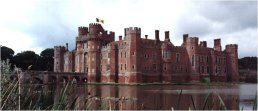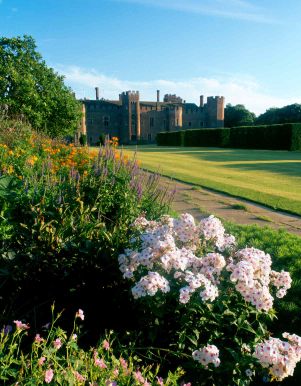|
HERSTMONCEUX
CASTLE
HOME
| SITE
INDEX
Herstmonceux
Castle,
overlooking the Pevensey Levels, "was built in 1440
by Sir Roger de Fiennes [otherwise
Fenys and Fynes], whose ancestor Sir John had early in
the previous century married the heiress to the estates,
Maud de Monceux" (1).
In
its original state, Herstmonceux Castle was "one of
the earliest really ambitious brick structures in
England" (2) - or as J.R. Armstrong puts it, the
Castle was "the first building of any size to be built
of [brick] since Roman times" (3). Roman
skills in brick-making lost under the Saxons were
reintroduced to Sussex, "probably under Flemish
supervision, for the building of Herstmonceux
Castle" (4). Mark Antony Lower says, "when in
full repair [it] was considered the largest private
house in the kingdom" (5).

Herstmonceux
Castle
Herstmonceux
was a significant place long before the Castle was
built. There is evidence of Roman remains, and in the
12th century a saxon lady, Idonea de Herst married a
Norman nobleman, Ingelram de Monceux, to give the place
it's name. The name of the owners changed through
marriage to Fiennes, and the family increased in wealth
and power. James Fiennes distinguished himself fighting
for King Henry V at the Battle of Agincourt and later
became sheriff of Surrey and Sussex.
It
was his elder brother, Sir Roger Fiennes, Treasurer of
the Household of Henry V1, who started building the
castle in 1441. This is one of the first major brick
buildings (today it is the oldest brick building of any
note still standing in England) and was years ahead of
it's time in other respects, with concentration more on
grandeur and comfort than on defence.
The
family fortunes are interesting and varied,but by 1700
the last Lord Dacre, Earl of Sussex, was forced to sell
Herstmonceux Castle. By the end of this century the
owner, Robert Hare had demolished most of it and used
the bricks to refashion Herstmonceux Place, further up
the hill.

Peter
Brandon calls the Castle one of the two "speciments
of feudal magnificence" in the County - the other
is Bodiam Castle - and "one of the stateliest and
largest houses in the kingdom": it has
"quadrangular shapes with symmetrically placed
polygonal towers in each of the corners... be-pinnacled
with smaller towers and turrets at intervals along the
curtain walls.... embellished with a noble gatehouse as
the main front" (6). It is, however,
"altogether, in spite of its moat, its battlements,
and its turrets, a mansion rather than a
castle" (7).
The
"site
lies very low" (Brandon) - that is, in common with
others of its time, it has no
"prospect". As Horace Walpole, seeing
it as something of a ruin, wrote to Richard Bentley on 5
August 1752, "the building, for convenience of the
moat, sees nothing at all" (8).
Roger
de Fiennes's son Richard, Sheriff of Sussex in 1452,
married Joan, heiress of Thomas, Lord Dacre, and was
"in her [sic] right... declared, in 1458,
Baron Dacre of the South". Dacre, whom Charles II
made Earl of Sussex, lost the estates "by
extravagance and gambling" (9). It passed to George
Naylor and the Hare family, "whose members ranged
from the eccentric to the downright mad" (10). In
1775 it was considered beyond repair and its interior
was demolished, the materials used for an addition to
Herstmonceux Place.
In
1794, Robert Marsham wrote to Gilbert White about "the
magnificent beeches of Herstmonceux Castle...
One beech felled here around 1750 had run 25m to the
first branch" (11). There is a rare black gum
tree (Eucalyptus aggregata) east of the moat.

The
castle had slowly deteriorated into a ruin by 1911 until
it was purchased by Lt. Colonel Claude Lowther.
Restoration
of the castle was begun in 1912 under Colonel Claude
Lowther who used local craftsmen to carry out building
works to the south front of the building. Col
Lowther was responsible for much of the present design
and for installing a number of pieces of fine woodwork
and panelling purchased from other great historic houses
in England. He died in 1929.
Then "more seriously and indeed exemplarily
by Sir Paul Latham in 1933" (12). The architect was
W.H. Godfrey of Lewes. The original four courtyards
were, however, made into one. Sir
Paul Latham contributed very greatly to the construction
of the castle both internally and externally. In 1946 he
sold it to the Admiralty who bought the estate for the
Royal Greenwich Observatory, and it became an important
scientific institution for the next 40 years.
In
1993 Herstmonceux Castle was acquired by Queen's
University of Canada through the generosity of Drs
Alfred and Isabel Bader, and is now an International
Study Centre attracting students from around the world.
It
was during a visit to their Sussex home that Drs Alfred
and Isabel Bader chanced on an advertisement offering
Herstmonceux Castle for sale, and their vision and
support for the potential of the Castle taking on a new
guise as an International Study Centre, bringing
students from all over the world to study in the beauty
and tranquillity of East Sussex countryside.

NOTES
(1) Judith Glover, Sussex Place-Names
their origins and meanings (Newbury:
Countryside Books, 1997), 107.
(2) Ian Nairn and Niklaus Pevsner, The
Buildings of England: Sussex (Harmondsworth:
Penguin Books, 1965), 50.
(3) J.R. Armstrong, A History of Sussex
(Chichester: Phillimore, 1961; 4th edition 1995), 75.
(4) Kim Leslie and Brian Short, eds, A
Historical Atlas of Sussex (Chichester:
Phillimore & Co. Ltd, 1999), 106.
(5) Mark Antony Lower, A Compendious History
of Sussex (Lewes: George P. Bacon, 1870),
I. 254.
(6) Peter Brandon, The Sussex Landscape
(London: Hodder and Stoughton, 1974), 134, 135.
(7) Nairn and Pevsner, 534.
(8) Horace Walpole, reprinted in Thomas Walker
Horsfield, The History, Antiquities and
Topography of the County of Sussex (Lewes:
Sussex Press, 1835), I.551.
(9) Lower, 255.
(10) John Godfrey, Sussex
(London: Michael Joseph, 1990), 98.
(11) Owen Johnson, The Sussex Tree Book
(Westmeston: the Pomegranate Press, 1998), 59.
(12) Nairn and Pevsner, 534-35.
LINKS
TO PARISH WEBSITE:
brief
history of Herstmonceux
Herstmonceux
Parish - vignettes from
Parish Council minutes
the
name "Herstmonceux"
the
Hundred of Foxearle
Herstmonceux
Castle
History
of Herstmonceux Castle
The
Royal Greenwich Observatory at Herstmonceux
Herstmonceux
Castle today
The
Science Centre & Discovery Park
The
Isaac Newton Observatory Trust plans
Herstmonceux
CE Primary School
All
Saints Church
Cowbeech
village: history & environment
Gardner
Street
small
houses and cottages
The
Met Office in Herstmonceux
village
conservation area & South East in Bloom Competition
Sussex
trug baskets
the
Steam House (Lime Park)
Wealden
Local Plan 1998 for Herstmonceux
population
of the Parish
listed
buildings in the Parish
protected
trees in the Parish
19th
Century Photographs
Windmill
Hill
The
Windmill Hill Windmill
The
Allfree School
more
about Herstmonceux history & environment
Herstmonceux
& Wartling Research Group
Varengeville-sur-Mer
(Normandy)
The
International Study Centre, Queen's University (Canada),
Hailsham,
East Sussex, England BN27 1RN
Tel: +44 (0) 1323 834444, Fax: +44 (0) 1323 834499
International
Study Centre Web Page
|
Opening
times and prices for 2005
How
to get to Herstmonceux Castle
16th April - 23rd October 10am - 6pm (last
admission 5pm) Closed Saturday 30th July.
In October closes one hour earlier.
Season tickets for the gardens and grounds
available - for further information please
contact 01323-834481
| Daily
Rates |
Gardens
& Grounds |
Gardens
& Grounds + Science Centre |
Castle
Tour |
| Adults |
£4.50 |
£9.60 |
£2.50 |
| Children
under 15 / students |
£3.00 |
£6.80 |
£1.00 |
| Children
under 5 |
Free |
Free |
Free |
Concessions:
Senior Citizens
Disabled |
£3.50 |
£7.50 |
£2.50 |
Family
Ticket
(2 adults + 3 children or 1 adult + 4
children) |
£12.00 |
£30.10 |
Not
applicable with family ticket.
Purchase tour tickets individually |
| *Group
rates (15+) |
Gardens
& Grounds |
Gardens
& Grounds + Science Centre |
Castle
Tours |
| Adults |
£3.50 |
£9.00 |
£2.50 |
|
Children
under 15 / students
|
£2.00 |
£5.90 |
£1.00 |
| Children
under 5 |
Free |
Free |
Free |
Concessions:
Senior Citizens
Disabled |
£3.00 |
£6.90 |
£2.50 |
*
We recommend that coach parties/groups
pre-book, please telephone 01323-834457
These prices are not valid for the Medieval
Festival or Special events.
The Castle is not open to the public, however
guided tours are conducted at an extra charge
and subject to availability, but due to the
operation of a busy working University we
strongly advise you to phone for confirmation
of times before your visit.
No
Tours 24th-31st July.
For
enquires please phone +44 (0) 1323 833816.
The
estate is also the site of the "hands
on" science centre which is open in the
famous Equatorial Telescope Buildings,
providing interest for all the family
(separate entry fee).
If you wish to visit both the Science Centre
and the Grounds and Gardens a whole days visit
is recommended . A joint ticket is available.
For
enquires please phone +44 (0) 1323 832731.
http://www.science-project.org/
|
|
Castle
History Book available by mail order priced:
£5.00 UK and £7.00 overseas (including
P&P)
Payment
in sterling only by credit card or cheques
made payable to:
Herstmonceux Castle Enterprises
at
Herstmonceux Castle
Hailsham
East Sussex
BN27 1RN
FAO:
Shop Manager
NB: Please include a delivery address
Local Tourism Web Sites
|
Herstmonceux
Electricity Generating Works Circa. 1900 - 1936
Links:
Introduction
| Instructions
| ISBN
| Batteries
| Boiler
Room | Floor
Plan | Ron
Saunders
Industrial
Revolution
| Lime
Park | Machinery
| Map
| Power
House | Argus
1999
Public
Supply | Roof
Construction | Rural
Supply | Sussex
Express 1913 |
Conclusion
Archaeology
South East |
East Sussex CC
| English Heritage
| SIAS
| Sx Exp 1999
Herstmonceux
Links Page
Wentworth
House
How
to get to Herstmonceux Castle
HOME |
WHISTLEBLOWING
|